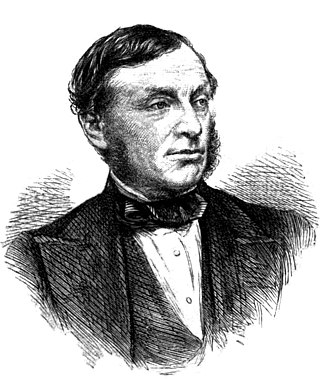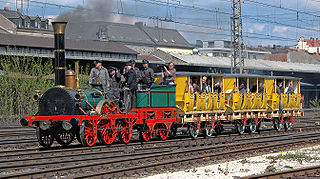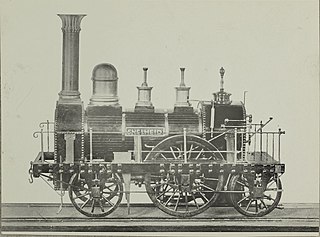
The Great Western Railway (GWR) was a British railway company that linked London with the southwest, west and West Midlands of England and most of Wales. It was founded in 1833, received its enabling Act of Parliament on 31 August 1835 and ran its first trains in 1838 with the initial route completed between London and Bristol in 1841. It was engineered by Isambard Kingdom Brunel, who chose a broad gauge of 7 ft —later slightly widened to 7 ft 1⁄4 in —but, from 1854, a series of amalgamations saw it also operate 4 ft 8+1⁄2 in standard-gauge trains; the last broad-gauge services were operated in 1892.

A Fairlie is a type of articulated steam locomotive that has the driving wheels on bogies. The locomotive may be double-ended or single ended. Fairlies are most famously associated with the Ffestiniog Railway in North Wales.

4-4-0 is a locomotive type with a classification that uses the Whyte notation for the classification of steam locomotives by wheel arrangement and represents the arrangement: four leading wheels on two axles, four powered and coupled driving wheels on two axles, and a lack of trailing wheels. Due to the large number of the type that were produced and used in the United States, the 4-4-0 is most commonly known as the American type, but the type subsequently also became popular in the United Kingdom, where large numbers were produced.

Sir Daniel Gooch, 1st Baronet was an English railway locomotive and transatlantic cable engineer. He was the first Superintendent of Locomotive Engines on the Great Western Railway from 1837 to 1864 and its chairman from 1865 until his death in 1889.

The first Locomotives of the Great Western Railway (GWR) were specified by Isambard Kingdom Brunel but Daniel Gooch was soon appointed as the railway's Locomotive Superintendent. He designed several different 7 ft 1⁄4 in broad gauge types for the growing railway, such as the Firefly and later Iron Duke Class 2-2-2s. In 1864 Gooch was succeeded by Joseph Armstrong who brought his standard gauge experience to the workshops at Swindon. To replace some of the earlier locomotives, he put broad gauge wheels on his standard gauge locomotives and from this time on all locomotives were given numbers, including the broad gauge ones that had previously carried just names.

Under the Whyte notation for the classification of steam locomotives, 2-2-2 represents the wheel arrangement of two leading wheels on one axle, two powered driving wheels on one axle, and two trailing wheels on one axle. The wheel arrangement both provided more stability and enabled a larger firebox than the earlier 0-2-2 and 2-2-0 types. This configuration was introduced in 1834 on Robert Stephenson's 'Patentee locomotive' but it was later popularly named Jenny Lind, after the Jenny Lind locomotive which in turn was named after the popular singer. They were also sometimes described as Singles, although this name could be used to describe any kind of locomotive with a single pair of driving wheels.
The Great Western Railway Premier Class 0-6-0 broad gauge steam locomotives for goods train work. This class was introduced into service between February 1846 and May 1847, and withdrawn between March 1866 and June 1872.

The Firefly was a class of broad gauge 2-2-2 steam locomotives used for passenger services on the Great Western Railway. The class was introduced into service between March 1840 and December 1842, and withdrawn between December 1863 and July 1879.
Tulk and Ley was a 19th-century iron mining company in west Cumberland which also ran an engineering works at Lowca near Whitehaven.
Haigh Foundry was an ironworks and foundry in Haigh, Lancashire, which was notable for the manufacture of early steam locomotives.
R and W Hawthorn Ltd was a locomotive manufacturer in Newcastle upon Tyne, England, from 1817 until 1885.

Nasmyth, Gaskell and Company, originally called The Bridgewater Foundry, specialised in the production of heavy machine tools and locomotives. It was located in Patricroft, in Salford England, close to the Liverpool and Manchester Railway, the Bridgewater Canal and the Manchester Ship Canal. The company was founded in 1836 and dissolved in 1940.
Mather, Dixon and Company was an engineering firm in Liverpool, England. It was established in 1826 at the Bath Street Foundry to build marine and stationary steam engines. Production of steam locomotives began in 1827.
The Avonside Engine Company was a locomotive manufacturer in Avon Street, St. Philip's, Bristol, England between 1864 and 1934. However the business originated with an earlier enterprise Henry Stothert and Company.
The Comet class were 12 4-4-0ST broad gauge locomotives operated on the South Devon Railway and associated railways. They were designed for passenger trains on this steep and sharply curved line but were also used on goods trains when required.
John Birkinshaw (1777-1842) was a 19th-century railway engineer from Bedlington, Northumberland noted for his invention of wrought iron rails in 1820.
Bedlington Ironworks, in Blyth Dene, Northumberland, England, operated between 1736 and 1867. It is most remembered as the place where wrought iron rails were invented by John Birkinshaw in 1820, which triggered the railway age, with their first major use being in the Stockton and Darlington Railway opened in 1825, about 45 miles (72 km) to the south.
The Daniel Gooch standard gauge locomotives comprise several classes of locomotives designed by Daniel Gooch, Superintendent of Locomotive Engines for the Great Western Railway (GWR) from 1837 to 1864.

The Snelheid was the name of the first locomotive in the Netherlands, which, together with the Arend, pulled the first train between Amsterdam and Haarlem.








